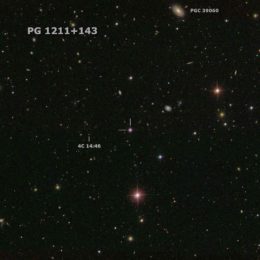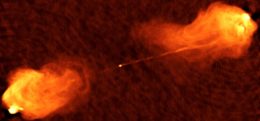The compact centers of active galaxies — known as active galactic nuclei, or AGN — are known for the dynamic behavior they exhibit as the supermassive black holes at their centers accrete matter. New observations of outflows from a nearby AGN provide a more detailed look at what happens in these extreme environments.
Outflows from Giants
AGN consist of a supermassive black hole of millions to tens of billions of solar masses surrounded by an accretion disk of in-falling matter. But not all the material falling toward the black hole accretes! Some of it is flung from the AGN via various types of outflows.The most well-known of these outflows are powerful radio jets — collimated and incredibly fast-moving streams of particles that blast their way out of the host galaxy and into space. Only around 10% of AGN are observed to host such jets, however — and there’s another outflow that’s more ubiquitous.
Fast-Moving Absorbers
Perhaps 30% of AGN — both those with and without observed radio jets — host wider-angle, highly ionized gaseous outflows known as ultra-fast outflows (UFOs). Ultraviolet and X-ray radiation emitted from the AGN is absorbed by the UFO, revealing the outflow’s presence: absorption lines appear in the ultraviolet and X-ray spectra of the AGN, blue-shifted due to the high speeds of the absorbing gas in the outflow.

Quasar PG 1211+143, indicated by the crosshairs at the center of the image, in the color context of its surroundings. [SDSS/S. Karge]
X-ray and Ultraviolet Cooperation
New observations are now providing fresh information about one particular UFO. A team of scientists led by Ashkbiz Danehkar (Harvard-Smithsonian Center for Astrophysics) recently used the Chandra and Hubble space telescopes to make the first simultaneous observations of the same outflow — a UFO in quasar PG 1211+143 — in both X-rays and in ultraviolet.
Danehkar and collaborators found absorption lines in both sets of data revealing an outflow moving at ~17,000 km/s (for reference, that’s ~5.6% of the speed of light, and more than 1,500 times faster than Elon Musk’s roadster will be traveling at its maximum speed in the orbit it was launched onto yesterday by the Falcon Heavy). Having the information both from the X-ray and the ultraviolet data provides the opportunity to better asses the UFO’s physical characteristics.

The X-ray spectrum for PG 1211+143 was obtained by Chandra HETGS (top); the ultraviolet spectrum was obtained by HST-COS G130M (bottom). [Adapted from Danehkar et al. 2018]
A Link Between Black Holes and Galaxies?
The authors use models of the data to demonstrate the plausibility of a scenario in which a shock driven by the radio jet gives rise to the fast bulk outflows detected in the X-ray and ultraviolet spectra.
They also estimate the impact that the outflows might have on the AGN’s host galaxy, demonstrating that the energy injected into the galaxy could be somewhere between 0.02% and 0.6% of the AGN’s total luminosity. At the higher end of this range, this could have an evolutionary impact on the host galaxy, suggesting a possible link between the black hole’s behavior and how its host galaxy evolves.
In order to draw definitive conclusions, we will need higher-resolution observations that can determine the total size and extent of these outflows. For that, we may need to wait for 2023, when a proposed X-ray spectrometer that might fit the bill, Arcus, may be launched.
Citation
Ashkbiz Danehkar et al 2018 ApJ 853 165. doi:10.3847/1538-4357/aaa427



2 Comments
Pingback: narrow jet and wide outflows from AGNs
Pingback: February 7, 2018 | Colorado Space News